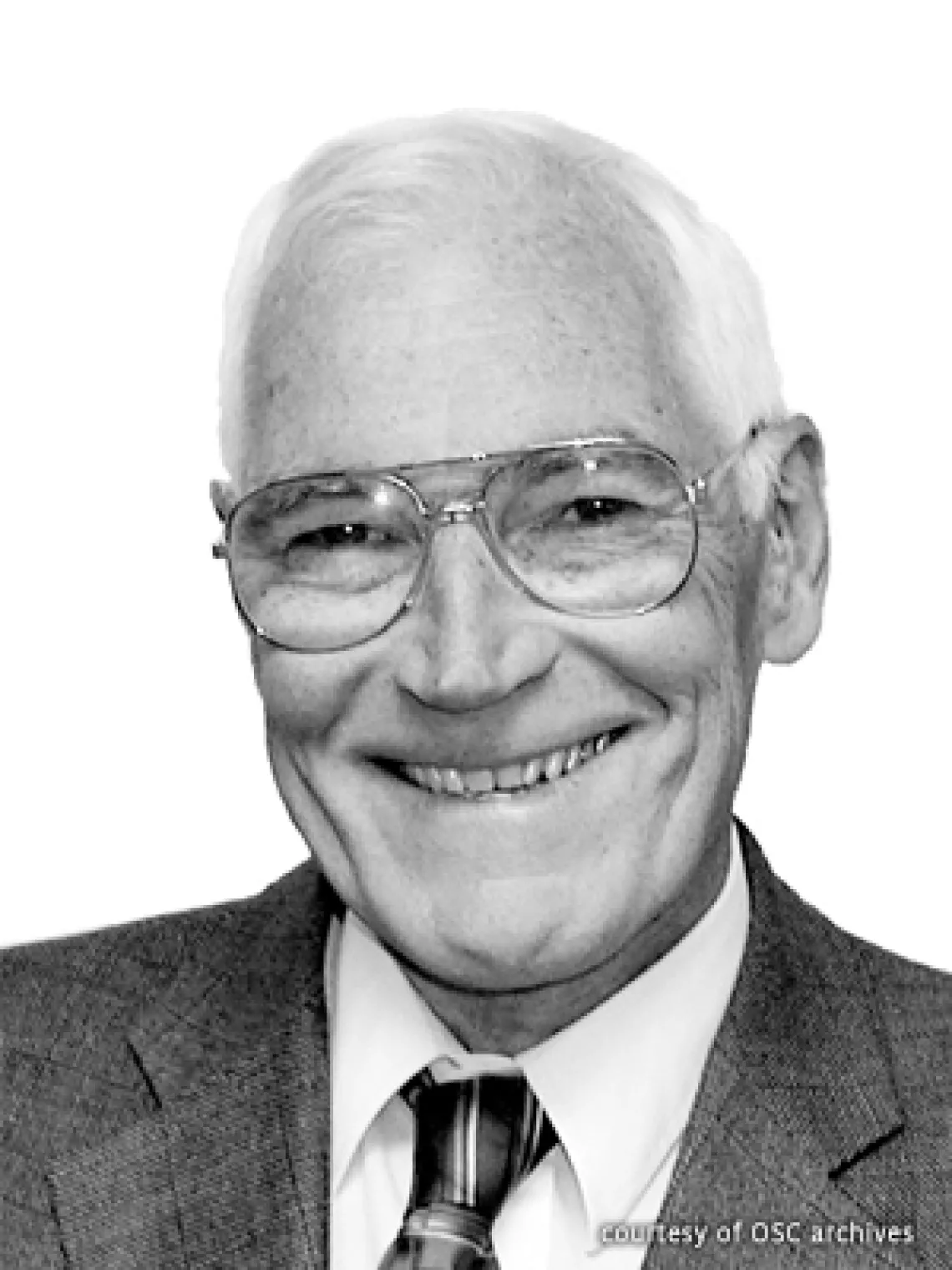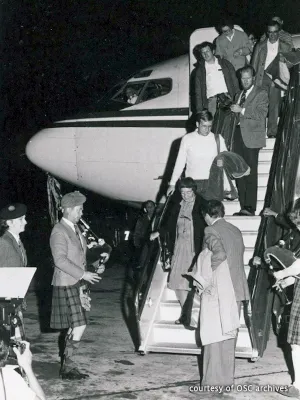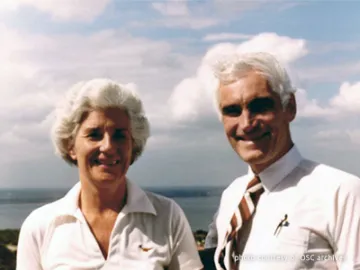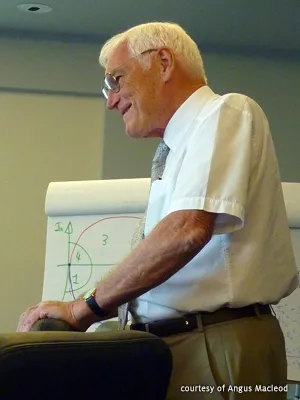Reflections: H. Angus Macleod

Practically invisible to the naked eye, thin-film optical coatings are used in millions of products that many people use in their daily lives. Found in everything from smartphone touchscreen displays to implantable medical devices, surface coatings play a vital role in almost every industry and are frequently the ultimate determinants of performance. With over 50 years of experience in thin-film optics, Professor Emeritus H. Angus Macleod is a world-renowned researcher and educator in the field. And just as with optical coatings, there is definitely more than meets the eye with Angus.
Early Life
Angus, of the Assynt branch of the Clan Macleod, was born in Glasgow, Scotland to a highland family from the northwest village of Scourie, where his grandfather owned the local general merchant store. His father had studied medicine at the University of Edinburgh and joined the Glasgow Health Service, much later absorbed into the National Health Service.
Angus was first introduced to physics at Lenzie Academy, about ten miles from Glasgow. From then on, although also interested in chemistry, physics was his passion. He graduated in 1954 from the University of Glasgow with a degree in natural philosophy (the Natural Philosophy Department has become the School of Physics and Astronomy). With very little science-based industry in Scotland, Angus headed south to London, England for a graduate apprenticeship with Sperry Gyroscope Company — much to the dismay of his relatives who feared he “would marry one of those English girls.” (Which, incidentally, is exactly what Angus did in 1957 when he married Ann, from Kent, whom he had met on the badminton court.)
Early Career
During his time at the University of Glasgow, Angus had been taught, by Austrian physicist Bruno Touschek, the use of vector and tensor algebra in solving rigid-body dynamics problems. As mechanical gyroscopes were wonderful examples, he found himself at Sperry happily working on all sorts of problems in vibration and nutation. But, the work he was doing was all defense related and the United Kingdom’s government policy was changing almost weekly.
Sensing Sperry’s future was uncertain, Angus left in 1960 for a position in a small survey camera and photographic instrument company, Williamson Manufacturing, well known for their high-altitude reconnaissance cameras. Williamson was his first introduction to real-world optics, as he found himself designing optical systems in addition to setting up an electronic design and development laboratory and production facility using the new transistors rather than electron tubes. According to Angus, his biggest contribution was “explaining the idea of a pupil to the drawing office where there was a tendency to draw all rays straight through the precise center of the lens.”
At the beginning of 1963, Angus left Williamson to join Mervyn Instruments, a small company that called themselves “Manufacturing Physicists.” They had been the first company to produce an infrared spectrometer using the new “blazed” gratings produced by the Merton-NPL process, and they were developing, amongst other things, a nitrous oxide analyzer for the British Army to check the sealing of their electronic equipment.
For this project, they discovered that they needed narrowband infrared filters at the nitrous oxide wavelength — and Angus was told he would be the one to make them. To this end, he was given a little 12-inch glass bell jar system with nothing inside it. As luck would have it, Oliver “Olly” Heavens, author of “Optical Properties of Thin Solid Films,” was down the road at Royal Holloway College. So Angus “legged it down the road,” to see Olly, forming a relationship that lasted many years. Once back at Mervyn, he drew up the plans for a 12-inch infrared coating machine with which they successfully made multiple-cavity filters for the infrared nitrous oxide band — the beginning of Angus’ career in optical coatings.
Thin Films
By the end of 1963, Mervyn Instruments had been sold to Gulton, Inc., an American company that made resistors and temperature controllers. Things went downhill fast, and given the keen sense of self preservation Angus had developed, he immediately recognized the danger signs and the feeble attempts at reassuring language like “we’re down to the muscle,” and “we’re down to the sinews,” and so on. By the time they were “down to the bone,” he had found another job at Sir Howard Grubb, Parsons and Company (Grubb-Parsons) as head of their optical coating department.
Grubb-Parsons was best known for astronomical telescopes and applications. However, gas-laser mirrors soon became their most lucrative product. They were the first in Europe to produce a hard-coated, helium-neon-laser mirror. While there, Angus had the good fortune to form a close relationship with Paul Cook of Scientifica-Cook Ltd., who manufactured the most reliable gas lasers in Europe in the late 1960s and early 1970s. Grubb-Parsons supplied them with all their gas-laser mirrors for many years, which turned out to be a very productive relationship — Scientifica-Cook cornered a very large part of the European market and pulled them along with them.
Academia
Around this time, at the height of Angus’ career with Grubb-Parsons, Neville Goodman of Adam Hilger Ltd., a small scientific book publishing company, asked him if he would be willing to write a book on optical filters. Angus explained that he was not competent to cover the entire range of optical filters — his field was thin-film optics and that was all he felt he could handle. “Wonderful,” Neville exclaimed, “that is exactly what I want.” Of course it was not what he originally wanted, but it immediately became just what he wanted.
Angus considers himself enormously lucky that his book, “Thin-Film Optical Filters,” was published and a great success just as Grubb Parson’s future was in doubt. Ready for another career move, Angus learned that a readership (research professorship) in thin-film physics had come available at Newcastle upon Tyne Polytechnic. He credits his getting the post to the timely success of his book.
The move to academia turned out to be a good move for Angus in every way. He found he enjoyed teaching and had a productive laboratory with first class research students and colleagues. During this time, he also acquired a reasonable record of publication and a Doctor of Technology degree. His early work dealt with manufacturing tolerances and errors. Angus also spent some time teaching in France as Professeur Associé at the University of Aix-Marseille, and he was awarded the degree of Docteur Honoris Causa by the university in 1997.
Across the Pond
One day in early 1978, Angus returned to his office from the computer lab and was given a message that said “There was some American on the phone who wanted to speak to you. He said he would call back later.” In a little while, the phone rang and the caller introduced himself as Peter Franken, the Director of Optical Sciences Center (OSC) at the University of Arizona.
Right away, Peter asked, “If we were to offer you a professorship in optical sciences, would you consider it?” I immediately said I would and Peter, after brief thanks, rang off, promising to get back to me sometime soon. What Peter probably didn’t know was that a Scot would consider anything … “We have this university at the South Pole. Would you consider it?” “Of course, I would consider it.”
Prior to Peter’s phone call, Angus had heard of the optical program in Arizona — he knew Professor Bill Wolfe was there and he had exchanged a fair amount of correspondence with Professor Francis Turner who was running a small thin-film group at OSC. What he didn’t know at the time was that Francis had encouraged Peter to look for someone else to help build the group.
At the end of October, Angus made his first trip to the United States to attend the annual Optical Society (OSA) meeting held in San Francisco and afterwards to visit OSC in Tucson. “To me, San Francisco was a ‘typical’ American city, because that’s all I knew. I ate my first American sandwich, astonished at having to choose from an incredible range of different breads and then at the enormous size.”
Peter arranged to meet with Angus at the OSA meeting and, over breakfast, explained that upon his visit to OSC the following week, he would be expected to give a seminar. And, as if that wasn’t enough of a surprise, Peter said he needed the title of Angus’ talk immediately — and it had to be catchy. Angus thought for about 30 seconds, “without inspiration,” and then suggested, “A bad case of rising damp.” Peter thought the title was wonderful, while Angus thought it was pretty weak.
I arrived in Tucson in the middle of a rare downpour. “If you can keep doing this you’ll make a fortune,” joked Peter. Then I had to give the seminar. What I had not realized was that rising damp, a progressive rise of moisture in a building wall often bringing all sorts of growths with it and well-known in Britain, was hardly known at all in southern Arizona. So, my title turned out to be much better than I had thought. All sorts of theories about what this could be were circulating at the Center.
The seminar was actually largely on the effects of moisture on optical coatings, at that time the main cause of their instability — hence, the title. At the start of the talk, I explained rising damp and Bill Wolfe immediately stood up and pretended to leave, saying that was all he had wanted to know. Peter interrupted several times and I handled that reasonably well — I observed later that he usually did this to see if he could shake the candidate.
Before I left, Peter handed me a letter offering me the position and suggested I should take time to think about it and talk it over with my family before giving my answer. Back in the UK, I talked with the family. It took them less than a minute to agree enthusiastically that we should do it.
Arizona Bound
It was decided that Angus would take a leave of absence from the Polytechnic until his immigrant visa was granted — a lengthy process due to the overwhelming amount of paperwork required. Finally, the visa was approved and Angus, Ann and their five children visited the U.S. Embassy in Grosvenor Square for the formalities that turned out to be an interview and lecture from one of the officials, fingerprinting, a medical exam including a chest x-ray, and the taking of an oath.

Alexander, our youngest at a week or two under ten years old, became more and more downcast as the process continued. He was too young to have his fingerprints taken, too young to have a chest x-ray and too young for the oath. He eventually cheered up over an excellent lunch we decided was definitely indicated. All the children were at boarding schools, the so-called public schools in Britain that were actually private. This was solely because of the quality of their education rather than boarding, but it meant that in early November 1979, Ann and I arrived first carrying our x-rays and photographs. The embassy had given us strict instructions about the photographs we must carry with us — their dimensions, their background, the angle of our heads and so on. We had spent considerable time and resources with our local photographer to assure the correctness of these in every detail. The first thing the immigration officer in Los Angeles did was to throw them away — “I don’t know why they did this to you. Nowadays, we take your pictures with a Polaroid.”
After immigration, we had plenty of time to catch the connecting flight to Tucson. The people at the check-in desk refused to issue boarding passes because they said we were too early. We came back at the time they said we should, to discover they had no seats for us. No one could explain how that could have happened but we were re-booked on a much later flight. As Peter was planning to pick us up at the airport in Tucson, I phoned him with the update but talked to his eldest daughter — Peter had already left rather early for the airport. What we didn’t know was that he had arranged a welcome for us, including pipers to pipe us off the plane. The pipers duly struck up, but of course we were missing — only our luggage was present. We finally arrived around midnight to an almost deserted airport and just Peter standing by our luggage.
Optical Sciences Center
Angus speaks very fondly of his immense good fortune at OSC to have exceedingly brilliant students from all over the world. “China was emerging from the Cultural Revolution when higher education had been suppressed. To correct this, a national program of visiting scholars was established. This allowed experienced, but under-qualified, scientists from China to spend usually one to two years in a U.S. University laboratory. At the time, I had a number of students from Taiwan in my group and, although relations were strained between the two countries, the Chinese visiting scholars mixed and worked happily together with the Taiwanese students in optical coatings. I have always felt that education and educational institutions play a very important role in bringing people from different countries together for a common good.”
Shortly after arriving at OSC, Angus wrote a teaching program for the university mainframe. To his surprise, OSC actually succeeded in selling a number of copies, although the money did not come to him. Angus’ first real commercial venture in thin-film software came in 1982 when he was asked to write a thin-film program for a coating company, using a Radio Shack Model III desktop microcomputer. Then in 1984, the Macintosh computer appeared and, although incredibly expensive, Angus had to have one. Software development on it was a bit primitive, but he soon had a reasonable program running for optical coating design. Around that time, Angus talked with Brian Newnam of Los Alamos National Lab. Brian also had a Macintosh and asked Angus if he might be able to supply him with the program he had written.
Thin Film Center Inc.
If you look at the history of Science and Technology, the part played by supporting wives is rather neglected. James Clerk Maxwell’s wife was his able assistant in his early work. The hand in Wilhelm Conrad Röntgen’s famous picture, using x-rays, was his wife’s. My wife, Ann, immediately reacted with enthusiastic encouragement — as has always been the case throughout our almost 60 years of marriage. Ann was quite clear that we should form a company and sell the program to Brian.

The first task was to obtain a tax identity from the Internal Revenue Service (IRS), so Ann telephoned them. “What’s the name of the company?” they asked. That was the one thing they had not thought of. “Thin Film Center,” Ann said with hardly a pause. They really didn’t do very much for a while — it was a spare time activity with the aim mainly of funding Angus’ attendance at conferences. Then a year or two later, Michael Kidger asked if Kidger Optics could represent them — the result being better recognition for Thin Film Center. They had a good arrangement with Kidger Optics for several years before parting company, but remaining friends.
Angus wishes “[he] could say that [he] had created a business plan that clearly showed the way forward and that [his] actions were in response to that plan, but truth is that luck and timing played major roles.” Thin Film Center was formed just at the time when the personal computer was making great inroads into industry. Companies were beginning to think they would be better off handing their software requirements to specialists. At first, Thin Film Center supplied just the smaller enterprises, but gradually this extended even to the largest companies in the business. By 1995, their company was doing so well that Angus decided to retire from OSC and focus on Thin Film Center full time. As an emeritus professor, he still teaches the course, “Optical Thin Films,” one semester a year.
There are four of us who own and work full time at Thin Film Center. Ann and my daughter, Eleanor, look after the business side. Chris Clark is the genius who, nowadays, develops the software. I am involved with the theory of the algorithms and the operation of the software, especially when we are developing something new, and I work a lot on scripts. There is still code in the program that I actually wrote, but an important activity is looking after our customers and training. Our philosophy is that support is what we actually do, and that the software is a tool that helps in support. We also try to write a reasonable number of papers to maintain visibility. We don’t manufacture coating ourselves — never compete with your customers.
The field of optical thin films has been very good to me. I cannot imagine a more friendly, supportive and open group of people than the international optical thin-film community. It sets an example the rest of the world would do well to follow. (Preface to “Thin-Film Optical Filters,” Fourth Edition)
Awards
-

SPIE, Gold Medal, 1987
-
OSA, Esther Hoffman Beller Medal, 1997
-
University of Aix-Marseille, Docteur Honoris Causa, 1997
-
International Conference on Vacuum Web Coating, John Matteucci Award, 2000
-
Society of Vacuum Coaters, Nathaniel H. Sugerman Memorial Award, 2002
-
European Vacuum Coaters, A Life For Thin Film Award, 2004
-
European Vacuum Coaters, Senator Award, 2008
